Kawasaki disease (strawberry tongue) associated with very low vitamin D
Severe vitamin D deficiency in patients with Kawasaki disease: a potential role in the risk to develop heart vascular abnormalities?
Clinical Rheumatology, May 2015 https://doi.org/10.1007/s10067-015-2970-6
Stefano Stagi, Donato Rigante, Gemma Lepri, Marco Matucci Cerinic, Fernanda Falcini falcini@unifi.it
Chart in the study
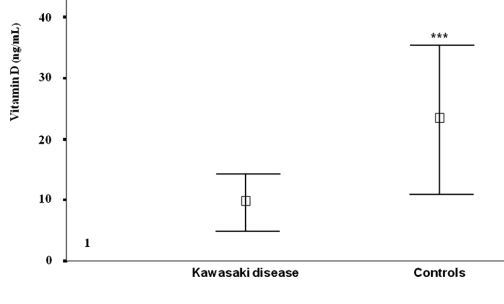
Twenty-five-hydroxyvitamin D (25(OH)-vitamin D) is crucial in the regulation of immunologic processes, but—although its deficiency has been reported in patients with different rheumatological disorders—no data are available for Kawasaki disease (KD). The goals of this study were to assess the serum levels of 25(OH)-vitamin D in children with KD and evaluate the relationship with the eventual occurrence of KD-related vascular abnormalities. We evaluated serum 25(OH)-vitamin D levels in 79 children with KD (21 females, 58 males, median age 4.9 years, range 1.4–7.5 years) in comparison with healthy sex-/age-matched controls. A significantly higher percentage of KD patients (98.7 %) were shown to have reduced 25(OH)-vitamin D levels (<30 ng/mL) in comparison with controls (78.6 %, p < 0.0001). Furthermore, KD patients had severely low levels of 25(OH)-vitamin D than controls (9.17 ± 4.94 vs 23.3 ± 10.6 ng/mL, p < 0.0001), especially the subgroup who developed coronary artery abnormalities (4.92 ± 1.36 vs 9.41 ± 4.95 ng/mL, p < 0.0001).
In addition, serum 25(OH)-vitamin D levels correlated not only with
erythrosedimentation rate (p < 0.0001),
C-reactive protein (p < 0.0001),
hemoglobin level at KD diagnosis (p < 0.0001) but also with both
coronary artery aneurysms (p = 0.005) and
non-aneurysmatic cardiovascular lesions (p < 0.05).
Low serum concentrations of 25(OH)-vitamin D might have a contributive role in the development of coronary artery complications observed in children with KD.
PDF is available free at Sci-Hub 10.1007/s10067-015-2970-6
First 2 pages given by publisher a free preview - image only - no translation possible
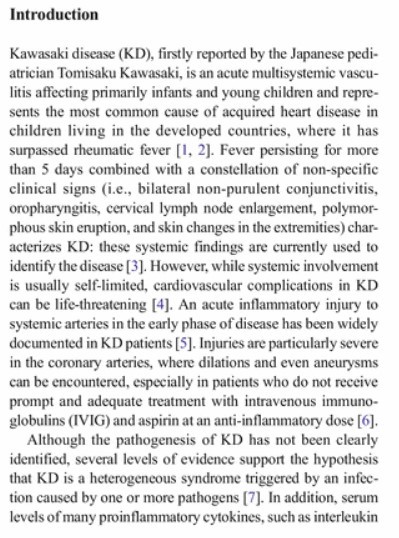

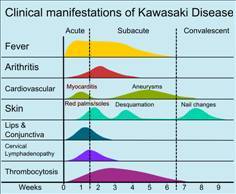
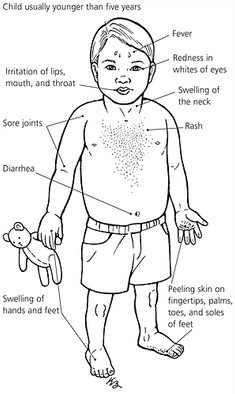
📄 Download the KD 2014 PDF from VitaminDWiki - noticed nothing about Vitamin D
- Introduction to Kawasaki Disease: Discover About This Illness That Primarily Affects Children Mercola Aug 2018, nice overview, no mention of Vitamin D
KD has had a recent seasonal cycle
which has gotten worse as vitamin D levels have been dropping
Note: the KD season is now in Winter-Spring - when vitamin D levels are the lowest
Note: very little connection between the winds(mentioned below) and KD before vitamin D levels became very low
chart from http://www.nature.com/news/infectious-disease-blowing-in-the-wind-1.10374
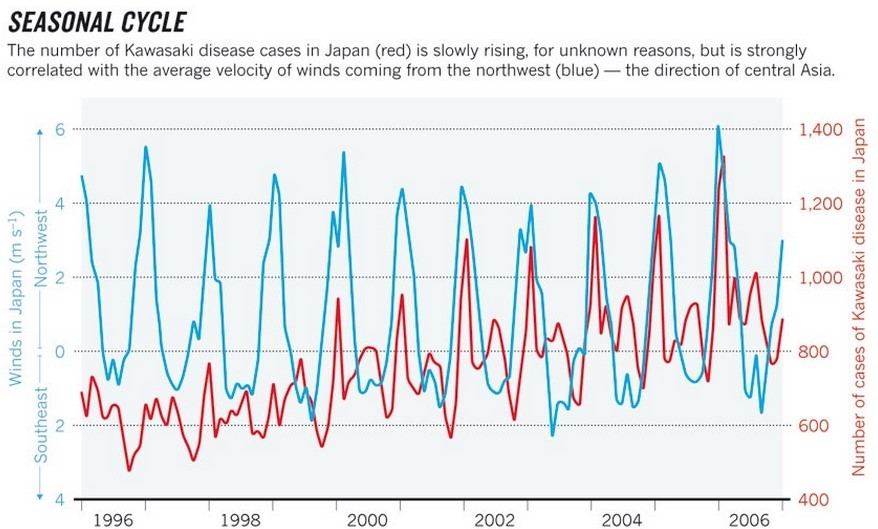
KD is the red line
Wonder if the winds cause such pollution that Japanese the children stay indoors and thus get less vitamin D?
VitaminDWiki reasons to suspect that KD can be prevented with Vitamin D supplementation
KD increases during the season which has the lowest vitamin D levels
KD affects those with dark skins more (dark skin carries a high risk of being vitamin D deficient when away from the tropics)
KD is an autoimmune disease - many of which can be prevented or treated by Vitamin D
KD has increased 2X in a decade - like 30 other diseases associated with low vitamin D
See also Criteria to associate a health problem with low vitamin D
Snips from Wikipedia entry – with VitaminDWiki comments
Autoimmune inflammation of lymph nodes
Without treatment, mortality may approach 1%
It is difficult to establish the diagnosis, especially early in the course of the illness,
- and frequently children are not diagnosed until they have seen several healthcare providers
May be associated with liver inflammation (which can be the cause of low vitamin D)
Kawasaki disease affects boys more than girls,
- with people of Asian ethnicity, particularly Japanese and Korean people, most susceptible,
- as well as people of Afro-Caribbean ethnicity. (darker skin ==> lower vitamin D)
- The disease was rare in Caucasians until the last few decades,
- (perhaps increase with recent lower levels of vitamin D) and incidence rate fluctuates from country to country
more than one in 150 children in Japan will develop Kawasaki disease during their lifetimes.
80% of patients younger than five years of age
US incidence of the disease doubled from 1991 to 2000
- which is yet another indication of vitamin D association:
- see VitaminDWiki Incidence of 22 health problems related to vitamin D have doubled in a decade
it appears to have replaced acute rheumatic fever as the most common cause of acquired heart disease in children
- More cases in winter in spring (times when vitamin D levels are the lowest)
(Note by VitaminDWiki: KD appears to be an orphan disease in US (but not in Japan 1 in 150)
References
Jamieson, N, Singh-Grewal, D (2013) Kawasaki disease: a clinician’s update. Int J Pediatr 2013: pp. 645391 CrossRef
Rosa, G, Pardeo, M, Rigante, D (2007) Current recommendations for the pharmacologic therapy in Kawasaki syndrome and management of its cardiovascular complications. Eur Rev Med Pharmacol Sci 11: pp. 301-308
Falcini, F, Capannini, S, Rigante, D (2011) Kawasaki syndrome: an intriguing disease with numerous unsolved dilemmas. Pediatr Rheumatol 9: pp. 17 CrossRef
Kato, H, Sugimura, T, Akagi, T (1996) Long-term consequences of Kawasaki disease. A 10- to 21-year follow-up study of 594 patients. Circulation 94: pp. 1379-1385 CrossRef
Burns, JC, Glodé, MP (2004) Kawasaki syndrome. Lancet 364: pp. 533-544 CrossRef
Rigante, D, Valentini, P, Rizzo, D (2010) Responsiveness to intravenous immunoglobulins and occurrence of coronary artery abnormalities in a single-center cohort of Italian patients with Kawasaki syndrome. Rheumatol Int 30: pp. 841-846 CrossRef
Esposito, S, Rigante, D, Principi, N (2013) The role of infection in Kawasaki syndrome. J Infect 67: pp. 1-10 CrossRef
Matsubara, T, Ichiyama, T, Furukawa, S (2005) Immunological profile of peripheral blood lymphocytes and monocytes/macrophages in Kawasaki disease. Clin Exp Immunol 141: pp. 381-387 CrossRef
Lips, P, Duong, T, Oleksik, A (2001) A global study of vitamin D status and parathyroid function in postmenopausal women with osteoporosis: baseline data from the multiple outcomes of raloxifene evaluation clinical trial. J Clin Endocrinol Metab 86: pp. 1212-1221 CrossRef
Spiro, A, Buttriss, JL (2014) Vitamin D: an overview of vitamin D status and intake in Europe. Nutr Bull 39: pp. 322-350 CrossRef
Stagi, S, Pelosi, P, Strano, M (2014) Determinants of vitamin D levels in Italian children and adolescents: a longitudinal evaluation of cholecalciferol supplementation versus the improvement of factors influencing 25(OH) D status. Int J Endocrinol 2014: pp. 583039
Outila, TA, Kärkkäinen, MU, Lamberg-Allardt, CJ (2001) Vitamin D status affects serum parathyroid hormone concentrations during winter in female adolescents: associations with forearm bone mineral density. Am J Clin Nutr 74: pp. 206-210
Huh, SY, Gordon, CM (2008) Vitamin D deficiency in children and adolescents: epidemiology, impact and treatment. Rev Endocr Metab Disord 9: pp. 161-170 CrossRef
Stagi, S, Bertini, F, Cavalli, L, Matucci-Cerinic, M, Brandi, ML, Falcini, F (2014) Determinants of vitamin D levels in children, adolescents, and young adults with juvenile idiopathic arthritis. J Rheumatol 41: pp. 1884-1892 CrossRef
Stagi, S, Cavalli, L, Bertini, F (2014) Vitamin D levels in children, adolescents, and young adults with juvenile-onset systemic lupus erythematosus: a cross-sectional study. Lupus 23: pp. 1059-1065 CrossRef
Holick, MF (2007) Vitamin D deficiency. N Engl J Med 357: pp. 266-281 CrossRef
Adorini, L, Penna, G (2008) Control of autoimmune diseases by the vitamin D endocrine system. Nat Clin Pract Rheumatol 4: pp. 404-412 CrossRef
Arnson, Y, Amital, H, Shoenfeld, Y (2007) Vitamin D and autoimmunity: new aetiological and therapeutic considerations. Ann Rheum Dis 66: pp. 1137-1142 CrossRef
Szodoray, P, Nakken, B, Gaal, J (2008) The complex role of vitamin D in autoimmune diseases. Scand J Immunol 68: pp. 261-269 CrossRef
Kudo, K, Hasegawa, S, Suzuki, Y (2012) 1α,25-Dihydroxyvitamin D (3) inhibits vascular cellular adhesion molecule-1 expression and interleukin-8 production in human coronary arterial endothelial cells. J Steroid Biochem Mol Biol 132: pp. 290-294 CrossRef
Newburger, JW, Takahashi, M, Gerber, MA (2004) Diagnosis, treatment, and long-term management of Kawasaki disease: a statement for health professionals from the Committee on Rheumatic Fever, Endocarditis and Kawasaki Disease, Council on Cardiovascular Disease in the Young, American Heart Association. Circulation 110: pp. 2747-2771 CrossRef
Falcini, F, Ozen, S, Magni-Manzoni, S (2012) Discrimination between incomplete and atypical Kawasaki syndrome versus other febrile diseases in childhood: results from an international registry-based study. Clin Exp Rheumatol 30: pp. 799-804
Ozdemir, H, Ciftçi, A, Karbuz, A (2013) Incomplete Kawasaki disease in an infant presenting with only prolonged fever. Turk J Pediatr 55: pp. 529-532
Stabile, A, Bertoni, B, Ansuini, V, Torraca, I, Salli, A, Rigante, D (2006) The clinical spectrum and treatment options of macrophage activation syndrome in the pediatric age. Eur Rev Med Pharmacol Sci 10: pp. 53-59
Zorzi, A, Colan, SD, Gauvreau, K, Baker, AL, Sundel, RP, Newburger, JW (1998) Coronary artery dimensions may be misclassified as normal in Kawasaki disease. J Pediatr 133: pp. 254-258 CrossRef
Webb, AR, Pilbeam, C, Hanafin, N, Holick, MF (1990) An evaluation of the relative contributions of exposure to sunlight and of diet to the circulating concentrations of 25-hydroxyvitamin D in an elderly nursing home population in Boston. Am J Clin Nutr 51: pp. 1075-1081
Holick, MF (2007) Vitamin D deficiency. N Engl J Med 357: pp. 266-281 CrossRef
Grant, WB, Holick, MF (2005) Benefits and requirements of vitamin D for optimal health: a review. Altern Med Rev 10: pp. 94-111
Fitzpatrick, TB (1986) Ultraviolet-induced pigmentary changes: benefits and hazards. Curr Probl Dermatol 15: pp. 25-38
Cacciari, E, Milani, S, Balsamo, A (2006) Italian cross-sectional growth charts for height, weight and BMI (2 to 20 yr). J Endocrinol Invest 29: pp. 581-593 CrossRef
Stagi, S, Bertini, F, Rigante, D, Falcini, F (2014) Vitamin D levels and effects of vitamin D replacement in children with periodic fever, aphthous stomatitis, pharyngitis, and cervical adenitis (PFAPA) syndrome. Int J Pediatr Otorhinolaryngol 78: pp. 964-968 CrossRef
Aydemir, G, Cekmez, F, Kalkan, G (2014) High serum 25-hydroxyvitamin D levels are associated with pediatric sepsis. Tohoku J Exp Med 234: pp. 295-298 CrossRef
Haan, K, Groeneveld, A, Geus, H, Egal, M, Struijs, A (2014) Vitamin D deficiency as a risk factor for infection, sepsis and mortality in the critically ill: systematic review and meta-analysis. Crit Care 18: pp. 660 CrossRef
Grzanka, A, Machura, E, Mazur, B (2014) Relationship between vitamin D status and the inflammatory state in patients with chronic spontaneous urticaria. J Inflamm (Lond) 11: pp. 2 CrossRef
Patel, S, Farragher, T, Berry, J, Bunn, D, Silman, A, Symmons, D (2007) Association between serum vitamin D metabolite levels and disease activity in patients with early inflammatory polyarthritis. Arthritis Rheum 56: pp. 2143-2149 CrossRef
Peterson, CA, Heffernan, ME (2008) Serum tumor necrosis factor-alpha concentrations are negatively correlated with serum 25(OH) D concentrations in healthy women. J Inflamm (Lond) 5: pp. 10 CrossRef
Dean, DD, Schwartz, Z, Schmitz, J (1996) Vitamin D regulation of metalloproteinase activity in matrix vesicles. Connect Tissue Res 35: pp. 331-336 CrossRef
Timms, PM, Mannan, N, Hitman, GA (2002) Circulating MMP9, vitamin D and variation in the TIMP-1 response with VDR genotype: mechanisms for inflammatory damage in chronic disorders?. QJM 95: pp. 787-796 CrossRef
Kendrick, J, Targher, G, Smits, G, Chonchol, M (2009) 25-Hydroxyvitamin D deficiency is independently associated with cardiovascular disease in the Third National Health and Nutrition Examination Survey. Atherosclerosis 205: pp. 255-260 CrossRef
Anagnostis, P, Athyros, VG, Adamidou, F, Florentin, M, Karagiannis, A (2010) Vitamin D and cardiovascular disease: a novel agent for reducing cardiovascular risk?. Curr Vasc Pharmacol 8: pp. 720-730 CrossRef
Syal, SK, Kapoor, A, Bhatia, E (2012) Vitamin D deficiency, coronary artery disease, and endothelial dysfunction: observations from a coronary angiographic study in Indian patients. J Invasive Cardiol 24: pp. 385-389
Klotz, B, Mentrup, B, Regensburger, M (2012) 1,25-Dihydroxyvitamin D3 treatment delays cellular aging in human mesenchymal stem cells while maintaining their multipotent capacity. PLoS One 7: pp. e29959 CrossRef
Furigay, P, Swamy, N (2004) Anti-endothelial properties of 1,25-dihydroxy-3-epi-vitamin D3, a natural metabolite of calcitriol. J Steroid Biochem Mol Biol 89–90: pp. 427-431 CrossRef
Nibbelink, KA, Tishkoff, DX, Hershey, SD, Rahman, A, Simpson, RU (2007) 1,25(OH)2-vitamin D3 actions on cell proliferation, size, gene expression, and receptor localization, in the HL-1 cardiac myocyte. J Steroid Biochem Mol Biol 103: pp. 533-537 CrossRef
Tarcin, O, Yavuz, DG, Ozben, B (2009) Effect of vitamin D deficiency and replacement on endothelial function in asymptomatic subjects. J Clin Endocrinol Metab 94: pp. 4023-4030 CrossRef
London, GM, Guérin, AP, Verbeke, FH (2007) Mineral metabolism and arterial functions in end-stage renal disease: potential role of 25-hydroxyvitamin D deficiency. J Am Soc Nephrol 18: pp. 613-620 CrossRef
Targher, G, Bertolini, L, Padovani, R (2006) Serum 25-hydroxyvitamin D3 concentrations and carotid artery intima-media thickness among type 2 diabetic patients. Clin Endocrinol (Oxf) 65: pp. 593-597 CrossRef
Suzuki, Y, Ichiyama, T, Ohsaki, A, Hasegawa, S, Shiraishi, M, Furukawa, S (2009) Anti-inflammatory effect of 1alpha,25-dihydroxyvitamin D (3) in human coronary arterial endothelial cells: implication for the treatment of Kawasaki disease. J Steroid Biochem Mol Biol 113: pp. 134-138 CrossRef
VitaminDWiki pages with KAWASAKI in title (3 as of July 2022)
This list is automatically updated
{LIST()}
